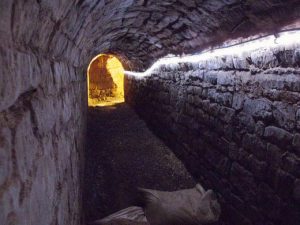 My second Lady Apollonia West Country Mystery, Plague of a Green Man, is set in Exeter, Devon, in the year 1380. One of the unique medieval features of Exeter which plays a small role in my story is Exeter’s Underground Passages. These were vaulted tunnels built under the city and beyond to bring water to the inhabitants. Lead pipes were laid in the tunnels to carry the water. At various access points in the town, workers could enter the underground tunnels to fix leaks and make other repairs without tearing up streets. This feature in Exeter was unlike anything else among English cities. The first phase of tunnel building was completed in 1346 with pipes terminating in a fountain in the cathedral close. I decided to have one of my characters use these tunnels to move about the city and escape detection.
My second Lady Apollonia West Country Mystery, Plague of a Green Man, is set in Exeter, Devon, in the year 1380. One of the unique medieval features of Exeter which plays a small role in my story is Exeter’s Underground Passages. These were vaulted tunnels built under the city and beyond to bring water to the inhabitants. Lead pipes were laid in the tunnels to carry the water. At various access points in the town, workers could enter the underground tunnels to fix leaks and make other repairs without tearing up streets. This feature in Exeter was unlike anything else among English cities. The first phase of tunnel building was completed in 1346 with pipes terminating in a fountain in the cathedral close. I decided to have one of my characters use these tunnels to move about the city and escape detection.
The tunnel system was enlarged in 1492 to serve more of the city. Because of cholera, the city improved the system in 1832, switching from lead pipes to cast iron. By 1857, however, this water system was abandoned. A modern picture of one of the tunnels is shown above.
My mentor, Ken Maun, when I was a steward and tour guide at Exeter Cathedral, grew up in Exeter well before World War II, and he remembered playing in the tunnels when he was a boy. In 1933 the tunnels were first opened to the public although no lighting was provided. Presumably one had to bring some kind of torch. Now, as shown above, they are a major tourist site for the public.
For more details on Exeter’s Underground Passages, click on https://exeter.gov.uk/leisure-and-culture/our-attractions/underground-passages/
Tags: Chaucer's England, historical fiction, medieval mysteries